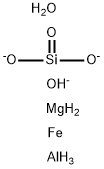Iron , 99.95%metalsbasis , 7439-89-6
Synonym(s):
FE;Iron;TF2E1;TF2E2;TFIIE-A
CAS NO.:7439-89-6
Empirical Formula: Fe
Molecular Weight: 55.85
MDL number: MFCD00010999
EINECS: 231-096-4
| Pack Size | Price | Stock | Quantity |
| 25G | RMB213.60 | In Stock |
|
| 100G | RMB733.60 | In Stock |
|
| others | Enquire |
PRODUCT Properties
| Melting point: | 1535 °C(lit.) |
| Boiling point: | 2750 °C(lit.) |
| Density | 7.86 g/mL at 25 °C(lit.) |
| Flash point: | >230 °F |
| storage temp. | 2-8°C |
| solubility | H2O: soluble |
| form | wire |
| color | Silvery |
| Specific Gravity | 7.86 |
| Odor | Odorless |
| Resistivity | 9.71 μΩ-cm |
| Water Solubility | INSOLUBLE |
| Sensitive | Moisture Sensitive |
| Merck | 13,5109 |
| Exposure limits | ACGIH: TWA 2 mg/m3 OSHA: TWA 15 mg/m3; TWA 5 mg/m3 NIOSH: IDLH 1250 mg/m3; TWA 2.5 mg/m3 |
| Stability: | Stable. Reacts slowly with moist air and water. Dust may form an explosive or combustible mixture with air. Incompatible with organic acids, strong oxidizing agents, water, mineral acids. |
| CAS DataBase Reference | 7439-89-6(CAS DataBase Reference) |
| NIST Chemistry Reference | Iron(7439-89-6) |
| EPA Substance Registry System | Iron (7439-89-6) |
Description and Uses
Carbonyl iron is elemental iron produced by the decomposition of iron pentacarbonyl as a dark gray powder. When viewed under a microscope having a magnifying power of 500 diameters or greater, it appears as spheres built up with concentric shells. It is stable in dry air.
Smelting of iron from its ore occurs in a blast furnace where carbon (coke) and limestoneare heated with the ore that results in the iron in the ore being reduced and converted tomolten iron, called “pig iron.” Melted pig iron still contains some carbon and silicon as wellas some other impurities as it collects in the bottom of the furnace with molten slag floatingatop the iron. Both are tapped and drained off. This process can be continuous since moreingredients can be added as the iron and slag are removed from the bottom of the furnace.This form of iron is not very useful for manufacturing products, given that it is brittle andnot very strong.One of the major advances in the technology of iron smelting was the development of theBessemer process by Henry Bessemer (1813–1898). In this process, compressed air or oxygenis forced through molten pig iron to oxidize (burn out) the carbon and other impurities. Steelis then produced in a forced oxygen furnace, where carbon is dissolved in the iron at very hightemperatures. Variations of hardness and other characteristics of steel can be achieved with theaddition of alloys and by annealing, quench hardening, and tempering the steel.Powder metallurgy (sintering) is the process whereby powdered iron or other metals arecombined together at high pressure without high heat to fit molded forms. This process is usedto produce homogenous (uniform throughout) metal parts.One of the most useful characteristics of iron is its natural magnetism, which it loses athigh temperatures. Magnetism can also be introduced into iron products by electrical induction. Magnets of all sizes and shapes are used in motors, atom smashers, CT scanners, and TV and computer screens, toname a few uses. Super magnets can be formed by addingother elements (see cobalt) tohigh-quality iron.Iron is an important element making up hemoglobinin the blood, which carriesoxygen to the cells of ourbodies. It is also very important as a trace element inthe diet, assisting with theoxidation of foods to produce energy. We need about10 to 18 milligrams of ironeach day, as a trace mineral.Iron is found in liver andmeat products, eggs, shellfish, green leafy vegetables,peas, beans, and whole graincereals. Iron deficiency maycause anemia (low red bloodcell count), weakness, fatigue,headaches, and shortness ofbreath. Excess iron in thediet can cause liver damage,but this is a rare condition.
Safety
| Symbol(GHS) |  GHS02 |
| Signal word | Danger |
| Hazard statements | H228 |
| Precautionary statements | P210 |
| Hazard Codes | F,Xi |
| Risk Statements | 36/38-11-17 |
| Safety Statements | 26-16-33-24/25 |
| RIDADR | UN 3264 8/PG 3 |
| WGK Germany | 1 |
| RTECS | NO4565500 |
| TSCA | Yes |
| HazardClass | 8 |
| PackingGroup | III |
| HS Code | 72052900 |
| Hazardous Substances Data | 7439-89-6(Hazardous Substances Data) |
| Toxicity | LD50 oral in rat: 30gm/kg |




